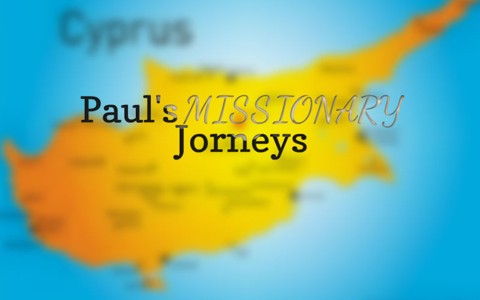Where did Paul go exactly in all of his missionary journeys?
Paul’s First Missionary Trip (44 AD – 50 or 51 AD)
The very first missionary journey that Paul took may have started around 44 AD where Paul, Barnabas, and Mark took off from Antioch which is recorded in Acts 13:4-5 where “by the Holy Spirit [they] went down to Seleucia and sailed from there to Cyprus. When they arrived at Salamis, they proclaimed the word of God in the Jewish synagogues. John was with them as their helper” which is where “They traveled through the whole island until they came to Paphos. There they met a Jewish sorcerer and false prophet named Bar-Jesus” (Acts 13:6).
Then, “From Paphos, Paul and his companions sailed to Perga in Pamphylia, where John left them to return to Jerusalem. From Perga they went on to Pisidian Antioch” (Acts 13:13-14a). After the Jewish leaders has “stirred up persecution against Paul and Barnabas, and expelled them from their region…they shook the dust off their feet as a warning to them and went to Iconium” (Acts 13:50-51). At Iconium they stayed there for “a long time” (Acts 14:3) but after receiving news that they were about to be stoned, they “fled to the Lycaonian cities of Lystra and Derbe and to the surrounding country, where they continued to preach the gospel” (Acts 14:6-7).
They later “returned to Lystra, Iconium and Antioch, strengthening the disciples and encouraging them to remain true to the faith” (Acts 14:210-22) and after “Paul and Barnabas appointed elders for them in each church” (Acts 14:23) then “going through Pisidia, they came into Pamphylia, and when they had preached the word in Perga, they went down to Attalia. From Attalia they sailed back to Antioch, where they had been committed to the grace of God for the work they had now completed” (Acts 14:24-26). That’s when Judas and Silas returned to Antioch (Syria) with Barnabas [2] and Paul where they stayed for many days (Acts 15:35-36) which was possibly in the winter of 50-51 AD.
Paul’s Second Missionary Trip (51 or 52 AD – 53 or 54 AD)
On the second of Paul’s missionary trip there was a problem where “Paul said to Barnabas, ‘Let us go back and visit the believers in all the towns where we preached the word of the Lord and see how they are doing.’” Barnabas wanted to take John, also called Mark, with them, but Paul did not think it wise to take him, because he had deserted them in Pamphylia and had not continued with them in the work. They had such a sharp disagreement that they parted company. Barnabas took Mark and sailed for Cyprus, but Paul chose Silas and left, commended by the believers to the grace of the Lord. “[Paul] went through Syria and Cilicia, strengthening the churches” (Acts 15:36-41). This worked out well actually because now there were two missionary trips to different places than one alone and more ground could be covered in this way.
His first visit was to Corinth where he stayed about a year and a half (Acts 18:1, 5, 11). Later Paul took Aquila and Priscilla with him to Cenchrea and then across the Aegean Sea to Ephesus (Acts 18:18) and from there “he set sail from Ephesus. When he landed at Caesarea, he went up to Jerusalem and greeted the church and then went down to Antioch” (Acts 18:21-22) and stayed there until approximately 53-54 AD and thus ended Paul’s second missionary trip.
Paul’s Third Missionary Trip (54 AD -58 AD)
“After spending some time in Antioch, Paul set out from there and traveled from place to place throughout the region of Galatia and Phrygia (central region of Turkey), strengthening all the disciples” (Acts 18:23) about 54 AD. Finally, traveling back through Ephesus he led many to faith in Christ but to the annoyance of the local charm dealers (Acts 19: 21– 40) staying there for three years. After going through Macedonia (northern Greece), Paul came to Achaia (southern Greece) where he stayed 3 months (Acts 20:2-3) where he apparently spent the winter of 57-58 AD and then Paul returned to Antioch by way of Jerusalem.
Paul later went to Assos, Mitylene, Chios, Samos, Trogylium, and Miletus (now in southwestern Turkey) and from there, Paul addresses the Ephesian elders (Acts 20:17-38). Sailing from there to Coos, Rhodes, Patara, and passing on the south side of Cyprus, they came to Tyre (modern day Lebanon) and went back to Jerusalem where the third missionary trip ends about 58 AD.
Paul’s Fourth and Final Trip (60 AD – 67 AD)
Paul’s final trip was a missionary trip per se. It did give him the opportunity do missionary work on the ship, along the way, and in Rome after Governor Festus sent Paul to Rome upon his appeal to Caesar (Acts 25:11). From there he sailed from Myra (now southern Turkey), then to Lasea, on the large island of Crete (Acts 27:7-13) and after staying there for some time he went on to Syracuse (an island of Sicily), from there to Rhegium (on the southern tip of Italy), finally to Puteoli (western coast of Italy) arriving as a prisoner of Rome from about 61-63 AD. While imprisoned there, he wrote many of what are called the “prison epistles” (letters) such as Ephesians, Philippians, Colossians [3], and Philemon.
Conclusion
It is believed that Paul traveled over 10,000 miles in his missionary work. There has never been any equal to Paul’s missionary work in all of human history. He has no equal in this regard. He was beaten, stoned, whipped, imprisoned, starved, frozen, but he never lost his joy and at the time of his writing Philippians, he was still chained to Roman guards. It’s interesting that Paul may have been at his lowest in writing what might be his most joyful epistle of all; the Book of Philippians, which is what many call “the Joy Epistle.” There has never been a greater missionary who suffered more for Christ and the church than the great Apostle Paul.
Enjoy this related article: Apostle Paul Biography and Profile [4]
Resource – Scripture quotations are from The Holy Bible, English Standard Version® (ESV®), copyright © 2001 by Crossway, a publishing ministry of Good News Publishers. Used by permission. All rights reserved.


